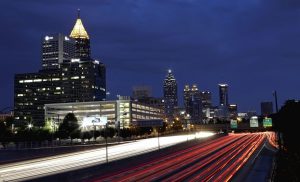
A new study finds that high-growth companies flock to neighborhoods that are more mixed-use and transit-accessible, whether in urban centers or suburbia.
For all the talk about tech firms heading back downtown, Amazon chose two HQ2 locations more on the fringes of urban centers—Long Island City, Queens, New York (roughly three miles from Midtown Manhattan) and Crystal City, Virginia (about four miles from downtown D.C.) But these are not traditional suburbs by any stretch of the imagination. They are dense, have mixed uses, and are accessible by transit. The tendency for high-growth firms to locate in such places in both urban and suburban areas is the subject of a new study published in The Professional Geographer.
In the study, authors Emil Malizia, of Carolina Planing, and Yasuyuki Motoyama, of the University of Kansas, argue that the debate over whether growing companies prefer cities or suburbs is oversimplified. Despite the recent shift of companies back to urban centers, more Americans continue to live and work in suburbs. And, for decades, suburban hubs like Silicon Valley and Route 128 outside of Boston were the preferred destination for the tech industry. The study examines the degree to which high-growth firms gravitate to more vibrant areas—defined as neighborhoods that are denser, more mixed-use, more transit-accessible, and more walkable—in both cities and suburbs.
Malizia and Motoyama identified firms based on Inc.’s yearly lists of the 5,000 fastest-growing privately-held firms, each taking in at least $2 million in revenue annually. Firms in the study qualified as “high-growth” because they grew by 20 percent each year for three years or had more than 72.8 percent compound growth over three years between 2007 and 2015. The study was not confined to particular industries, but those represented prominently in the sample included tech, advertising and marketing, business products and services, government services, and health.
The sample comprised roughly 6,000 high-growth firms across 30 selected U.S. metro areas (Malizia and Motoyama excluded New York and Los Angeles because those metros are so large that they might have skewed the results). They measured vibrancy according to characteristics such as density and compactness, diversity of land uses, walkability, and accessibility to transit, based on data from the EPA’s Smart Location Database (SLD).
To read the entire article go to CityLab here. (By Richard Florida for CityLab)
Note: Emil Malizia is a Carolina Planning Professor and CURS Faculty Fellow.